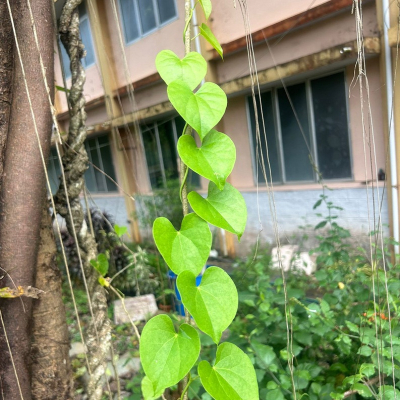Tinospora cordifolia (Willd) Miers ex Hook. f. & Thoms.
Synonyms : Menispermum cordifolium Willd , Cocculus cordifolius (Willd) DC
Family : Menispermaceae
Group : Antidiabetic, Anti-arthritic/anti-rheumatic/anti-inflammatory, Antipyretic
Parts Used : Root , Leaf , Stem
Vernacular Names :-
| English | : | Tinospora |
| Malayalam | : | Chittamrithu |
| Hindi | : | Giloe |
| Sanskrit | : | Amrita |
| Kannada | : | Amritaballi |
| Tamil | : | Amridavalli |
| Telungu | : | Tivantika |
Distribution and habitat: Widely seen in tropical countries like India, Myanmar, SriLanka and in Andaman Islands. It is mostly found trailing on forest trees, fences and hedges along the boundaries.
Botany: Climbing shrub with rough corky bark.
- Leaves : Glabrous, cordate 5-10 cm broad, acute or accuminate. The plant is dioecious.
- Flowers : Yellow in lax racemes, arising from the nodes on the old wood. Male flowers are in fascicles; sepals oval; petals half the length of sepals. Female flowers are usually solitary, having ovary on the fleshy receptacle.
- Fruits : Drupes, red when ripe.
Properties: The plant is antigonorrhoric, stomachic, antispasmodic, anti-inflammatory, stimulant, diuretic, emetic, antidiabetic, aphrodisiac, antiperiodic, antileprotic antirheumantic and tonic. The root is an emetic in large doses. The tincture and extract are alterative tonic and in a less degree antiperiodic and diuretic.
Chemical constituents: The plant contains cordifol, tinosporidine, tinosporide, berberine, heptacosanol, β-sitosterol, cordifolone, tinosporon, tinosporic acid, tinosporol, cordifolide, tinosporine, magnoflorine and tembetarine.
Uses:
- Tinospora is used in medicine, usually in the fresh state, though it is commercially available in the dried state. It is probably one of the most useful preparations acting as a tonic and aphrodisiac. As a tonic it is best given in infusion with or without milk.
- It is a popular remedy for snakebite and leprosy.
- It is generally prescribed in general debility, diabetes, fever, jaundice, skin diseases, rheumatism, urinary diseases, dyspepsia, gout, gonorrhoea and leucorrhoea.
Formulations: Guduchayado churna, Gududyadi kwath, Guduchilouha, Amritarista, Sanjivanivati, Guduchi taila, Amiritastak kwath, Amritharishtam
Agrotechnology
Soil and climate: It requires a warm humid tropical climate with an annual rainfall of 2000-3000 mm. It thrives well in deep fertile soils that are rich in organic matter. Acidic to neutral soils are preferred though it can come up in alkaline soils as well.
Propagation: It is propagated through stem cuttings. About 10-15 cm long stem cuttings having at least 2 nodes are planted in the field or polybags. Treatment of cut ends with rooting hormones gives better results. The usual planting time is with the onset of monsoon in May-June. Usually it is planted along boundaries or nearby tall trees and allowed to trail on the trees or hedges and hence regular spacing is not followed.
Manuring: While planting, adequate amounts of organic manure are applied.
After cultivation: Once the plant is established no much management is needed.
Harvesting: The stem is the most economic part. Harvesting can be commenced after one year and usually partial harvesting is followed depending on the necessity. The stem and root should be collected in hot season when the concentration of the bitter principle is the highest. A full-grown well-ramified plant may give 2-3 kg vines, which are cut into smaller pieces and traded either fresh or after drying.

